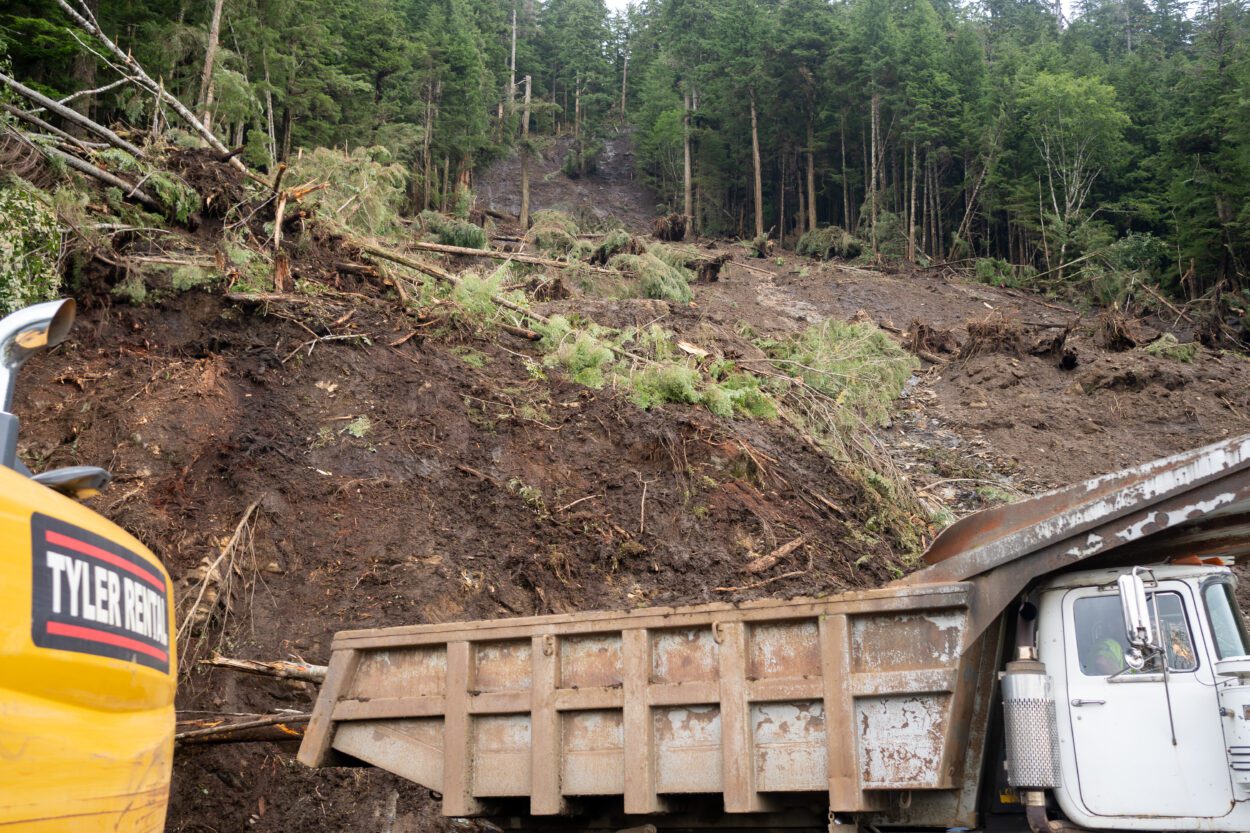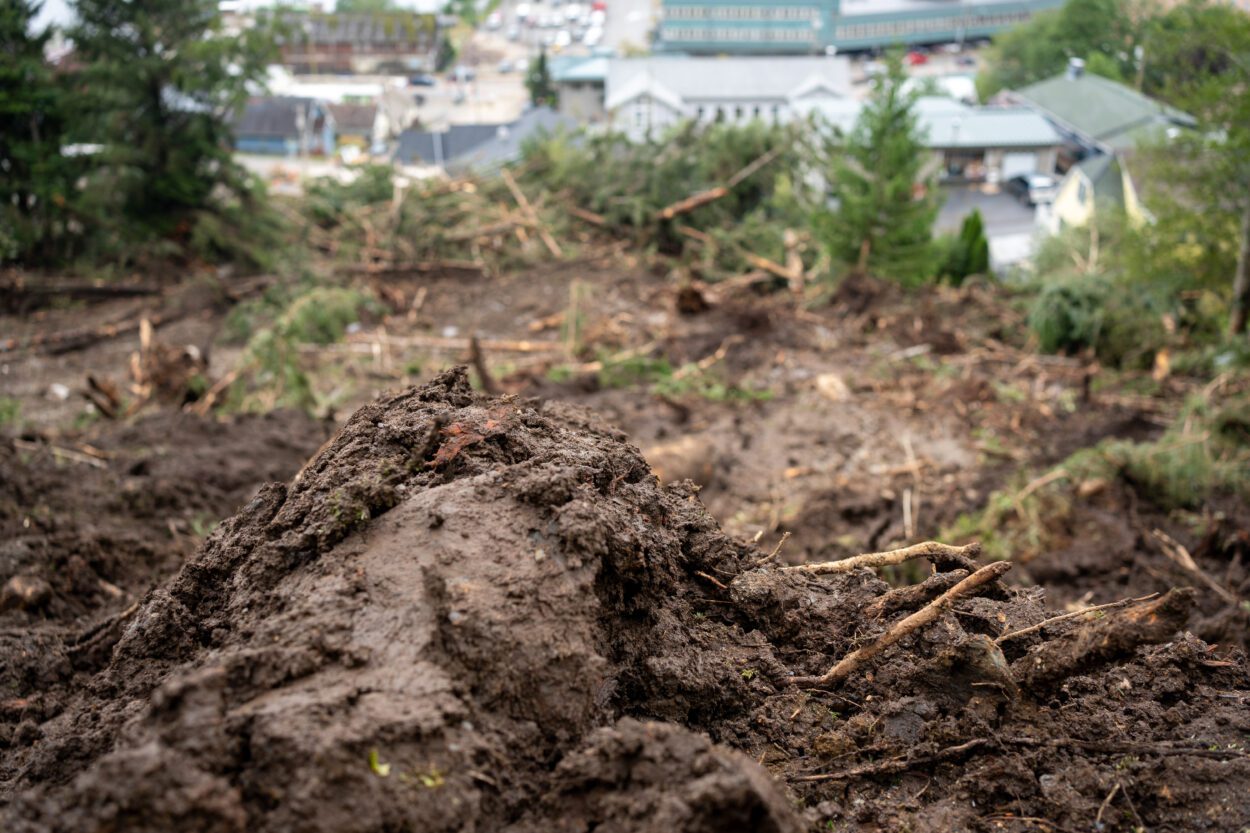
The Ketchikan City and Borough invited a panel of experts to answer community questions on Wednesday evening in the wake of the city’s deadly landslide.
Some of the most common questions directed at the panel were about the weather. It was less than four days after the landslide that tore through the Whitecliff neighborhood. The rain had started again and people wanted to know if they were going to be okay.
“The landslide was a traumatic event for a lot of people, even myself,” said Borough spokeswoman Kacie Paxton, who was hosting the panel. “When the rain started today – you know, it had been nice for a couple of days – but I felt that sense of stress. Many people have lost a lot of things: loved ones, pets, their homes, belongings. Many people are carrying stress and anxiety about their safety, their wellbeing, the future, what’s going to happen this fall.”
The slide happened after a day of heavy rains. The weather was clear in the aftermath, while state geologists tested the hillside for the potential of further slides.
Aaron Jacobs is a hydrologist and meteorologist with the National Weather Service. He said they’re keeping a close eye on the forecast.
Jacobs said at the Silvis Lake weather station on the island, they measured over 10 inches of rain in less than 24 hours leading up to the hillside collapsing on Sunday. He said that Ketchikan is largely equipped to handle that much rain but the city has actually received less rain than usual this year. There was a long period of warm, dry weather leading up to Sunday’s rainstorm. Jacobs said that could’ve been a factor.
“Overall, for the year, we’re almost 25 inches below normal. So we’re looking further in to see if that’s playing into any of the reasons for this horrible event,” said Jacobs, but he added that it’s not that simple – soil saturation and erosion could be other factors. “It takes more than just precipitation or heavy precipitation to cause these events.”
According to Jacobs, a new weather station at the slide site will monitor future rain events in the immediate area. Jacobs said that with more rain, the tongue of mud and debris left by the slide will move and shift but not to be afraid, it’s normal. He said if you see a steady stream of brown water outside the slide zone or unusual movement on the hillside, that’s when you should alert officials.
This is the fourth fatal landslide in Southeast Alaska in less than a decade. They’ve claimed the lives of 12 people. Community members wanted answers on what is being done to prevent more of these in the future.
Mort Larsen manages the Landslide Hazards Program for the state’s Department of Natural Resources. He said one of their priorities is to map areas in danger of future slides.
“We want to identify areas potentially that can be susceptible to landslides, and it’s just good information. But what this does is it gives city planners and emergency responders information that they need to be able to send messages out to folks, and then they can plan on top of that,” said Larsen.
Though, Larsen said the challenge is that even with all the catastrophic slides in recent years, the data is sparse. To know how Southeast can better prepare, he said, we need to know what is actually happening here.
“We need better geologic mapping. We need more detailed geological mapping to know what type of soil types are out there in bedrock,” said Larsen.
He added that the state Department of Natural Resources is working to secure a grant through FEMA’s Cooperative Technical Partnership program. They did the same in Wrangell and Haines after their landslide disasters. Larsen said the grant would help them build more weather stations in the area and expand their data-gathering capabilities. In the meantime, while those systems are being put in place, Larsen said that people should start making landslide emergency and evacuation plans – and if you notice something, don’t be afraid to act and leave the area.
“Don’t question yourself about that. You got a gut feeling. Do the right thing,” he said.
The state Emergency Operations Center was also on deck to answer questions about financial assistance for victims of the slide. They encouraged people to apply for the state’s Individual Assistance Program, which provides grants for home repair, replacing essential items, addressing medical needs, and providing temporary housing, among other things. LaNita Copeland with the EOC encouraged people to apply as early as possible because the number of people applying could encourage FEMA to get involved with federal funding.
Mental health was also targeted in the crisis response. Copeland said many in the community are now faced with the task of coping.
“Mental health and emotional health are truly something that often gets overlooked or set aside when you’re in the disaster and in the moment,” said Copeland. “But it can come back in full force and really hit individuals hard. It’s very natural and normal for that to happen.”
Copeland said following other disasters around the state, they have deployed their canine crisis team – a group of dogs and handlers trained to offer comfort to those coping with fear and loss. The canine crisis team will be deployed to Ketchikan next week.
Victims of the landslide can apply for state financial assistance by calling (844) 445-7131 or online at ready.alaska.gov. People are encouraged to register their financial losses due to the landslide as soon as possible. The deadline to apply is October 27.






